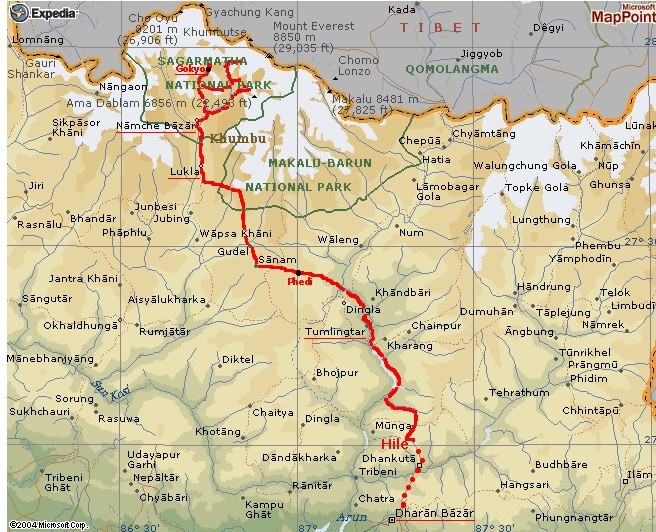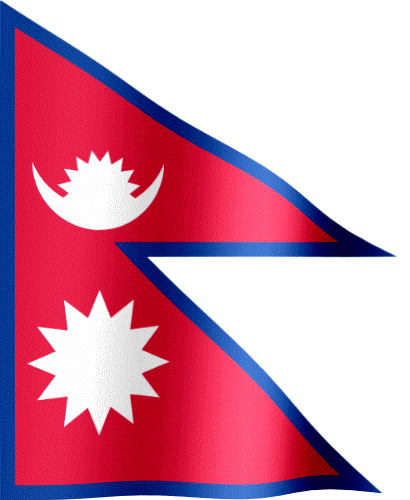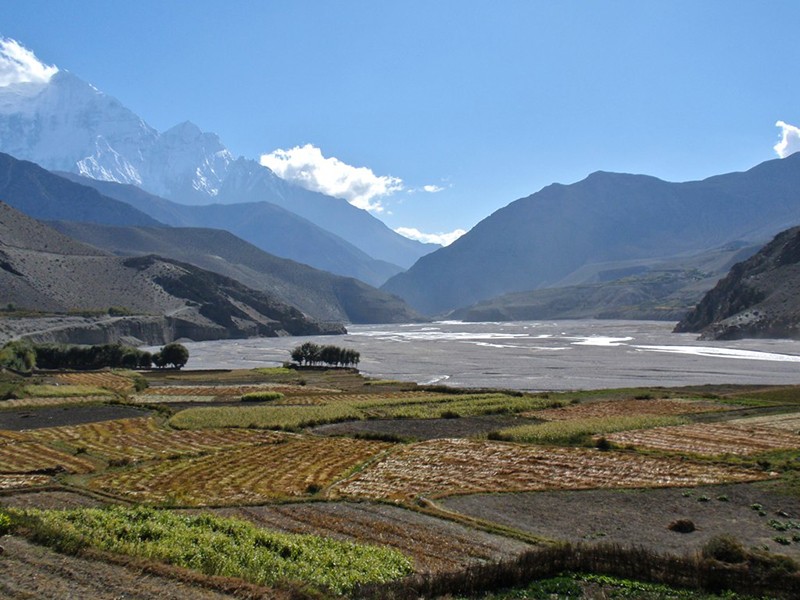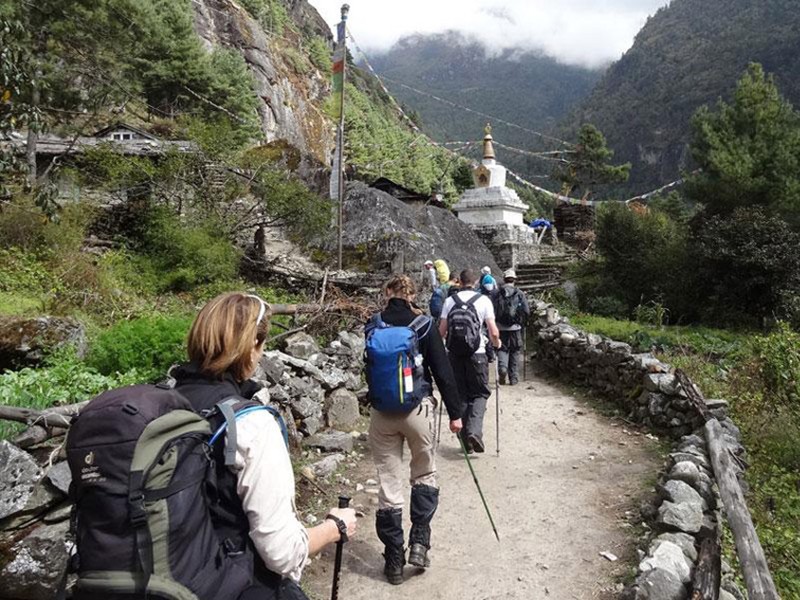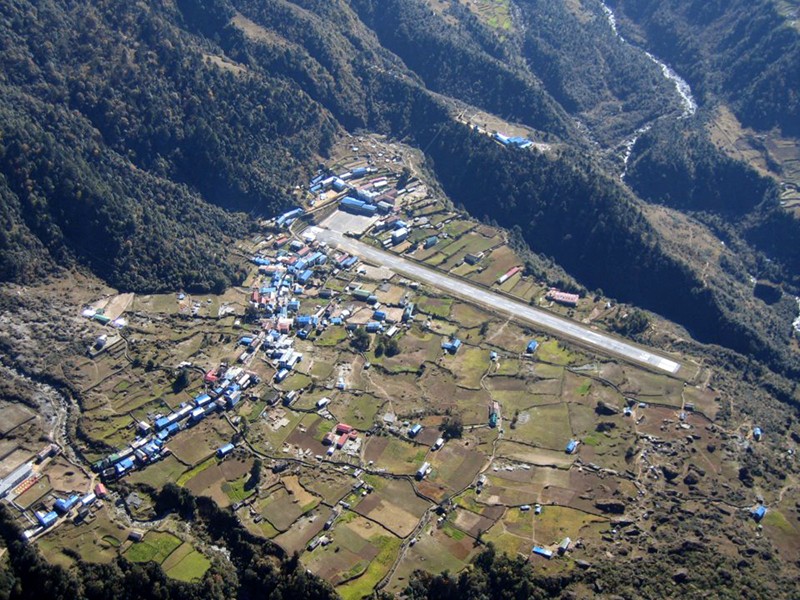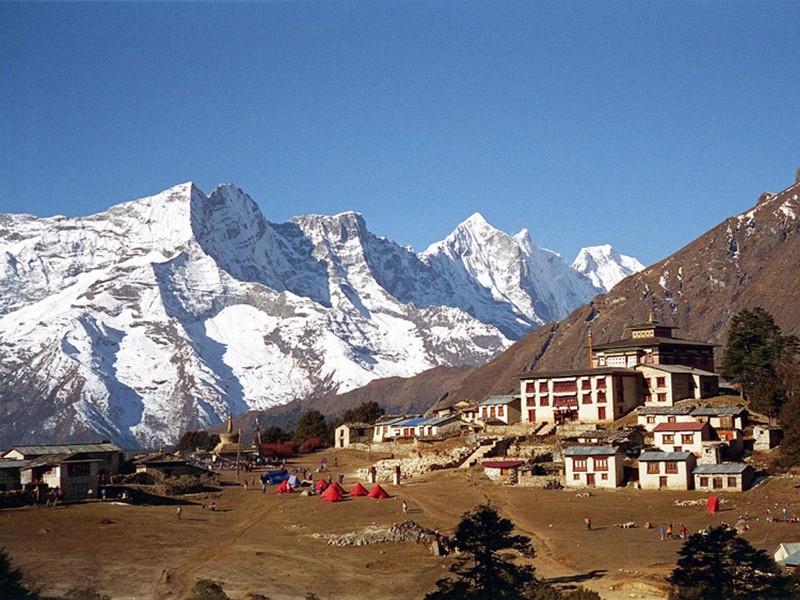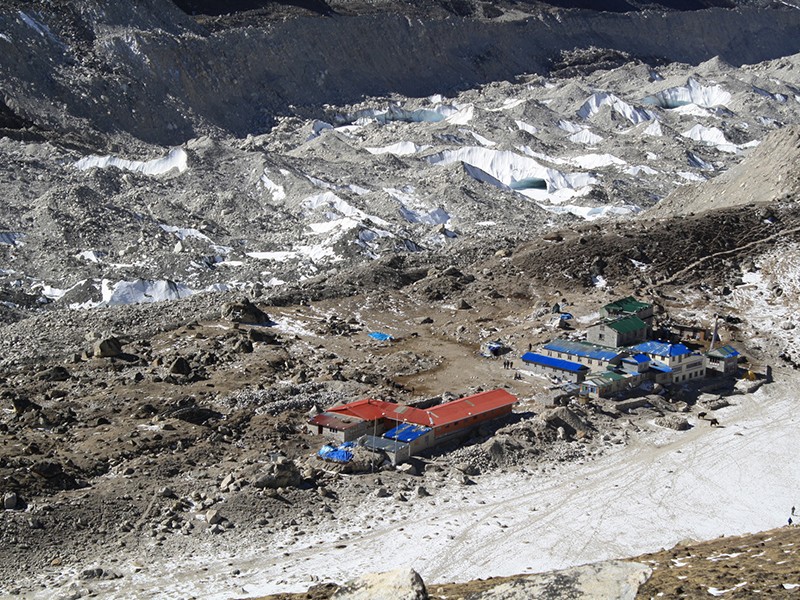Reference Code: AVETNP
Trip Start: Kathmandu
Trek Start: Tumlingtar
Trek Days: 23 Days
Age: 20 to 60 years
Season: Autumn
Accommodation: Lodge
Service: Full Board
Destination: Nepal
Trip End: Kathmandu
Trek End: Lukla
Trip Durations: 27 days
Physical Rating: Strenuous
Group Size: 4-12
Theme: Walking and observation
Meals: Standard
The region has been largely ignored by the trekkers. For Botanists, bird-watchers and amateur geologists this region is a perfect choice to trek. It is the habitat of over 80 species of mammals and rare species of birds are found here. Some of the earliest settlers.
Rais and Limbus are found here. Trek starts from Hille or Tumlingtar till the base camp retrace back to Tumlingtar or head towards Lukla. For more adventurous proceed towards Sherpani COL (6081m) and enter Chukung valley to walk down toward Namche finally to fly out from Lukla.
Day 01 Arrival in Kathmandu and transfer to hotel
Namaste! And welcome to Kathmandu, the colourful capital of Nepal where ornately carved balconies mingle with beautiful shrines and temples. Your adventure begins with a welcome meeting on arrival at the exit gate of Kathmandu airport. Our staff will welcome you and pick you to your accommodated hotel. Please seek our company palmplate to find our staff at the main exit gate of the airport. Rest of the day you can relax at the hotel or short evening walk around local market on your own as per your wish.
Day 02 Rest and Preparation day
A well deserved rest day at cosy of hotel after a long tiring flight. This day, one can move around nearby local market to purchase or hire trekking equipment that is necessary for the trekking like sleeping bags, walking sticks etc, exchange currency as requirement or simply walk around in the local market or Kathmandu Durbar squire nearby with small entrance fee as per your preference on your own. Evening at the hotel lobby there will be pre-trip briefing in which you will be introduced with your trekking guide and explained about your trip in short, instruction for safety etc.
Day 03 Fly to Tumlingtar(410m.) and Trek to Kartiki Ghat
Fly from Kathmandu to Tumlingtar early in the morning to start the trek through the Arun Valley. we'll have beautiful views over the city, the Himalaya, and of the terraced fields below.
After arriving in Tumlingtar, begin our trek. The mountains in the distance are Chamalang to the left and Makalu to the far right. Follow the small road through the long village and adjoining series of small, lively villages and colorful tea-houses. Many locals will share the trail, as well as trains of mules carrying cardamom, the biggest cash crop in the region. After an hour, reach a fantastic suspension bridge with side ties, stretching across the wide Arun River. Then, drop down to the sandy riverside, peppered with boulders. Following the river closely, pass terraced rice fields, buffalos, thatched huts and villagers working in the fields.
Have lunch at Chewa Besi, then continue to Kartiki Ghat, a village known for bees and honey.
Day 04 Trek to Gothe Bazaar
Start the morning with an easy 20-minute walk to the lovely village of Balwa Besi, where we cross a small river. Then, start climbing through a lush, tropical forest of cardamom, banana and papaya trees, and past thatched huts to a chautara (local rest-spot), which is a spectacular viewpoint high above the hazy valley and the Arun River. We then have quite a climb before lunch.
Contouring around hillsides, climb to Marduwa, a small hamlet, passing more terraced fields and clusters of ochre and cream mud-brick houses built in the local style. Stop for lunch near Nepali Danda (also called Charlissay). Reach the intersection of the old trail from Dingla, and after contouring around a hillside, join a larger trail near a cluster of banyan trees. The forest thickens as we ascend and then drop back down to the Irkhuwa River, crossing two bridges and following a riverside trail for another hour or so to Gothe Bazaar. Here, the inhabitants are Gurung and Rai.
Day 05 Trek to Salpa Phedi(1700m.)
After breakfast, head towards Lankuwa village and then further on to Dhobani, a village of paper-makers. Delicious tangerines are sold along the trail by local villagers, so pick up some for the day. Cross the river on a flexing bamboo bridge and trek through several small picturesque whitewashed villages with thatched roofs. Pass through Lankuwa village and then start the steep, uphill climb to Dhobani. Along the way, keep an eye out for the traditional fishermen with their long bamboo nets. Continue through a thick tropical forest, climb the 'waterfall steps' and eventually reach Tala (Lower) Phedi, where paper is also made.
Stop for lunch before hiking another hour uphill along a lovely trail backed by undulating grasses, rocks, and fruit trees. Reach Salpa Phedi, where we;ll stay overnight.
Day 06 Trek to Guranse(2920m.)
Start the morning with a steep climb up stone steps through upper Salpa Phedi, then keep climbing, with increasingly amazing views down the valley. It will take you several hours of climbing to reach Jau Bari, a village that grows the best barley in the region. Here, there is a Sherpa monastery just below a lovely Sherpa-run campsite. Stop for a breather here, then continue past terraced fields and through rhododendron forests. Pass the turnoff for Salpa Lake and stop overnight at a local porter stop with several Sherpa houses.
Day 07 Trek to Sanam(2650m.) by crossing Salpa Bhanjyang(3358m.)
he Salpa Bhanjyang pass (11,023 feet/ 3,360 m) is the border of Solu Khumbu and the Sherpa region. It's a short ascent to get here, just over an hour to the chorten-topped windy pass, where there are wonderful views of snow-capped Karylung Peak. Descend steeply through the forest following a small stream and several mani walls to the Lidung Khola. There, cross to the north bank and continue to a few local teahouses. An hour or so afterward, reach the picturesque Sherpa village of Sanam, a lovely village with traditional Sherpa houses and terraced fields.
Day 08 Trek to Gudel(2068m.)
Leaving Sanam, contour along a high trail with broad views, first reaching Duire (Tiu), a group of simple lodges. Soon afterward, arrive at the rustic gompa at Nimtsola. Here, Sherpa influence ends as you enter the land of the Rai. The trail is now larger. Finally, reach the buffalo huts and terraced fields of the large Rai village of Gudel, a bustling and interesting place. The village of Bung and the Naulekh mountains are visible in the distance, as is Mera Peak. Descend steeply on slate steps to a campsite at the back of a local teahouse, your stop for the night.
Day 09 Trek to Kiraune Gompa
Today is a long but rewarding day. Begin by steeply descending past rice paddies and cardamom plants to the river far below. Cross a long bridge and begin the equally steep ascent to Bung. Following the stream on a rock trail, ascend a switch-backing trail after crossing the Hungu Khola. Bung means 'beautiful flower' in the Rai language, and is indeed a lovely large village, renowned for its tongba (millet beer).
The entrance to the Makalu Barun National Park is just past the school in the village. Continue to trek with great views and cooler temperatures until reaching a grassy plateau, your lunch stop. After a bit of 'off-trail' climbing, arrive in the recently built Kiraunle-Chambaling Gompa, your stop for the night.
Day 10 Trek to Najing Dingma by crossing Surke Pass(3085m.)
Today there is another pass crossing, which takes two and a half to three hours to reach the crest. Heading straight to the ancient moss-covered chortens and mani walls on the ridge, pass through a rhododendron forest. At the intersection by the teahouses, head up towards the Surkie pass (10,072 feet/ 3,070 m) There are better views at the sightseeing platform just above the narrow pass ridge, from where you'll be able to see Karylung, Khatang, and Numbur mountains.
Afterward, the descent is steep down along a rocky trail and through a bamboo forest, but you'll soon arrive at your overnight destination, Najing Dingma. This tiny hamlet and grazing area has a few small teahouses and shops, set on a flat green section of the hillside.
Day 11 Trek to Panggom(2804m.)
Today is another day of steep climbs and a pass. Descend from Najing Dingma for an hour through leafy woods, to Gai Kharka, another small village of only a few thatched huts. Continue descending steeply to the rickety bridge high above the Inkhu Khola. From here, make the steep ascent up a path, about which the owner of a nearby teahouse said: "It's so steep that even the monkeys fall off!" It takes two to three hours to reach the next village, but as you gain altitude you are also treated to spectacular views of the Inkhu Valley, with Mera Peak looming ahead.
Shubuche (2,660 m) is a large village spread over the hillside, marked by Tibetan prayer flags. From there, it will take another hour of climbing to reach the two small teahouses below the pass, and another hour to reach the Pangum La (or Satu La) pass (3,175 m). From there you'll be able to see the trail from Jiri, the Trakshindo La and the incredibly scenic Sherpa village of Pangum below.
After another half hour's walk, reach your scenic campsite at the back of a friendly Sherpa lodge. Pangom is home to a few nice lodges, the Hillary School, fields marked by wooden fences and a Tibetan Buddhist gompa. Enjoy a fantastic sunset across the wide open valley, with Karylung rising majestically in front across the Dudh Kosi (the 'milk river' that leads to the Khumbu region).
Day 12 Trek to Paiya(2730m.)
Today is another day of steep climbs and a pass. Descend from Najing Dingma for an hour through leafy woods, to Gai Kharka, another small village of only a few thatched huts. Continue descending steeply to the rickety bridge high above the Inkhu Khola. From here, make the steep ascent up a path, about which the owner of a nearby teahouse said: "It's so steep that even the monkeys fall off!" It takes two to three hours to reach the next village, but as you gain altitude you are also treated to spectacular views of the Inkhu Valley, with Mera Peak looming ahead.
Shubuche (2,660 m) is a large village spread over the hillside, marked by Tibetan prayer flags. From there, it will take another hour of climbing to reach the two small teahouses below the pass, and another hour to reach the Pangum La (or Satu La) pass (3,175 m). From there you'll be able to see the trail from Jiri, the Trakshindo La and the incredibly scenic Sherpa village of Pangum below.
After another half hour's walk, reach your scenic campsite at the back of a friendly Sherpa lodge. Pangom is home to a few nice lodges, the Hillary School, fields marked by wooden fences and a Tibetan Buddhist gompa. Enjoy a fantastic sunset across the wide open valley, with Karylung rising majestically in front across the Dudh Kosi (the 'milk river' that leads to the Khumbu region).
Day 13 Trek to Phakding(2610m.)
The trail now leaves the tributary valley and heads more directly north towards Chaurikharka (8,900 feet/ 2,713 m). Before ascending, the main trail crosses a spectacular deep gorge with a high waterfall (7,900 feet/ 2,408 m). Chaurikharka, a large scattered village with a monastery and a high school, is the breadbasket of the Khumbu area, as the land is fertile and crops like barley, wheat, and green vegetables are grown. After this village, the trail from Lukla joins that towards Phakding. The path becomes quite busy with trekkers, porters and pack animals. Several hours of walking along a scenic trail bring you to Phakding.
Day 14 Trek to Namchebazaar(3440m.)
After a flat walk along the Dudh Kosi river we climb steeply climb to Namche Bazaar (3,440m), the most important Sherpa town and a former trading centre with Tibet.
Day 15 Rest day
Today is an acclimatisation day. Namche Bazaar is well worth exploring, with its Buddhist monastery and distant views of Everest. For better acclimatisation it is recommended that you walk to the Everest View Hotel (½ day walk) or to one of the nearby villages such as Khunde, or Thame.
Day 16 Trek to Tengboche(3860m.)
After our rest day we set off trekking again. Within an hour the towering summit of Ama Dablam appears to the east, while glimpses of Everest lure us onwards. The gentle trail crosses the Dudh Kosi river at Phuki Teng where we start the long climb up to Tengboche.
Day 17 Trek to Pheriche(4240m.)
We descend to the Dudh Kosi river through rhododendron forests. If you are trekking in the spring you may see the rhododendron forests in bloom. We continue to Pangboche village where the monastery once held a possible yeti scalp, apparently stolen a few years back. We overnight at Pheriche (4,252m).
Day 18 Rest day
We have an acclimatization day at Pheriche, and a local walk to gain height during the day is recommended, returning to spend a second night at the same altitude. This is a very important aspect of our trek and will undoubtedly assist with the success, as well as with our enjoyment of it.
Day 19 Trek to Lobuche(4910m.)
Leaving Pheriche, we head over dry grazing lands, climbing gradually to Dughla. The surrounding stony wastes are the terminal moraines of the mighty Khumbu glacier, which we climb over to reach Lobuche (4,930m.) a cluster of shepherds’ huts and tea houses.
Day 20 Trek to Gorakshep(5140m.) and Explore Everest Base camp(5364m.)
Hemmed in by high peaks, the early morning sun is slow to reach Lobuche. It first hits 7,161m Pumori, which we head for as we leave the village and skirt the tongue of the Khumbu glacier. The trail gets rougher as we traverse the glacial debris where an adjoining glacier flows down from Changri La. At reaching Gorakshep, we leave our extra luggage in the lodge. After lunch we will walk up to Old Everest Base camp and return to Gorakshep for overnight.
Walking hours:
Altitude gain/loss:
Accommodation: Lodge/camp
Day 21 Early morning ascent Kalapathar(5550m.) and decent to Lobuche(4910m.)
Today will be an exciting day. In the rarefied air, we will need frequent stops but if we are lucky with the weather there will be stunning views to feast our eyes upon. We aim to reach the summit of Kala Pattar (5,623m), a steep, but not difficult climb. From its summit we may enjoy uninterrupted views of Everest’s black south west face, seemingly dwarfed by its neighbouring giant Nuptse. Khumbu’s tortured ice field stretches away to the south in an unbroken panorama of snowcapped mountains.
Day 22 Trek to Pangboche(3930m.)
We descend the Imja Khola Valley to the village of Pangboche, (3,901m), with its 300 year old monastery containing wall paintings and Tibetan manuscripts.
Day 23 Trek to Namche Bazaar(3440m.)
Through Deboche (3,757m) we continue to Thyangboche Monastery in a magical setting that commands impressive views of shapely Ama Dablam, then on through woodland to reach Namche Bazaar. An optional evening walk will give us our last views of Everest.
Day 24 Trek to Lukla(2840m.)
We may awake to the sound of Tibetan horns high above the village. From here the deep valley of the Dudh Khosi drops away as we retrace our steps to Lukla
Day 25 Fly to Kathmandu(1350m.)
Weather-permitting, we fly from the tiny mountain airstrip back to Kathmandu, with a last chance to glimpse the mighty snowcapped Himalaya in the distance.
Day 26 Final shopping day
This is the final day in Nepal. A chance to do some shopping, explore at leisure or merely relax by the hotel. We enjoy a final night together, reliving the trek and our extraordinary achievements. Shop in some of Kathmandu's many markets for clothing, embroidery, carpets or ceramics. If shopping is not your thing, take a trip over the Bagmati River to the adjacent city of Patan, with its abundance of temples and monasteries.
Day 27 Final departure
We say 'Namaste' for memories that will last a lifetime. There are no activities planned for today and you are able to depart the hotel at any time. Check out time from the hotel is at 12 noon. If you are departing later, you can arrange luggage storage at the hotel. For your final departure, our staff will pick you up from the hotel and transfer to Kathmandu airport approximately 3 hours prior to your international flight time.
Inclusion
Camping basis
All ground transportation as per itinerary
5 night hotel accommodation in Kathmandu with B/B plan.
½ day sightseeing in Kathmandu valley with English Speaking Cultural guide
Both way domestic Air fare (KTM-Tumlingtar) and (LUK-KTM) with airport tax
Cargo charges
TIMs (Trekking Information Management system)
Makalu Barun National Park and Everest National Park Entry fee
Food for the members on camping basis
All camping equipment and camping charges
Medical supplies(First aid Kit will be available)
All required Nepalese staffs (salary, food, clothing, accommodation)
All Nepalese staffs insurance as per Nepalese government rules
Company service charge, VAT and government taxes etc.
Exclusion
International flight with airport tax.
Nepalese Entry Visa fee
Food during stay in Kathmandu
All personal equipment and personal expenses
Photography Charges, Monument charges and Monument entry fees
Personal Medical and travel insurance(must cover helicopter rescue evacuation cost)
Personal Medicine
Telephone and internet charges
Laundry charges
Alcoholic beverage, bottled drinks and cold drinks during the trip
Rescue evacuation charges if required
Staffs and porters Tips...
Equipment List
Clothing and Equipments List
» Pack to pack out - bring enough waterproof bags to carry all non-biodegradable rubbish back down the mountain.
» Remove all unnecessary packaging before leaving home.
» Bring enough warm dry clothes so that you can wrap up rather than burn firewood in the evenings.
» If you are going to trek higher than 5000m or you know it will be cold, buy an aluminum water bottle which can also be used as a hot water bottle at night.
» The easiest way to keep hydrated while trekking is to buy a 1 x liter platypus-drinking bladder to carry in your day pack.
» Make sure to buy proper trekking socks. Don’t buy synthetic socks as these promote sweating and can give you blisters. Always carry a few blister pads in your first aid kit and keep them handy in your day pack.
» Walking poles are very useful while trekking and helpful when descending.
» Please remember that waste disposal and recycling facilitates are limited in Nepal. When buying batteries make sure they are rechargeable and/or high quality so they last longer, and take them home to recycle.
More Lists
There is no definitive list. What you bring will vary according to the area, time of year and the length of your trek. Below is a suggested check list which you should adapt to your own needs. Ask yourself: Will there be snow/how long /high is the trek/are we camping?
» Good quality trekking boots with ankle support
» Lightweight shell/raincoat with hood
» Detachable fleece liner or separate fleece
» Fleece trousers
» Shorts and / or convertibles trousers- quick drying
» Sunglasses
» Sun hat and warm hat(good quality)
» Gloves
» Spare T-shirt x 3
» Sweat towel x 2
» Spare socks x 3 ( walking sock and thin inner sock)
» Small day sack
» Sun cream
» Small water bottle aluminum doubles as a hot water bottle.
» Iodine or water purifying kit,
» Soluble vitamin tablets to taste water or powder fruit drink
» Talcum powder
» Walking sticks or Trekking poles(good quality)
» Camp shoes/trainers/flip flops to wear in evening.
» Spare underwear 3
» Toilet kit
» Tissues
» Pen knife
» Bum bag
» Head torch(good quality)
» Biodegradable washing liquid / soap
» FILM
» CAMERA
» Ear plugs
» Sleeping bag liner(good quality)
» Sleeping bag(good quality-30)
» Bin bag/ gasbag to keep kit dry
» Small towel
» Lip balm
» Available in KTM
Personal First Aid (Aids Kit)
» Antiseptic
» Bandages
» Blister plasters
» Decongestant
» AMS medication like Diamox
» Eye drops – it can get very dusty on trails
» Paracetamol and/or ibuprofen
» Rehydration sachets, Imodium and antibiotics for traveler’s diarrhea
» Scissors
» Sterile dressing
» Sticking plasters and tape
» Throat lozenges / sweets
» Tweezers
» A sewing needle etc.
This trekking equipment list has been prepared by Adventure Zambuling Treks (P) Ltd.
